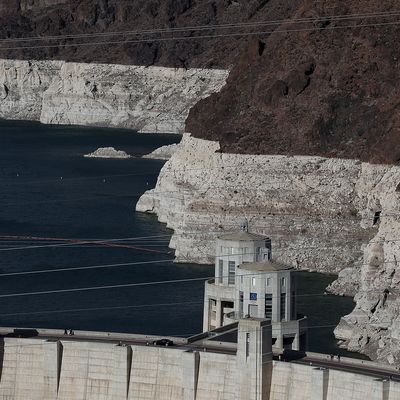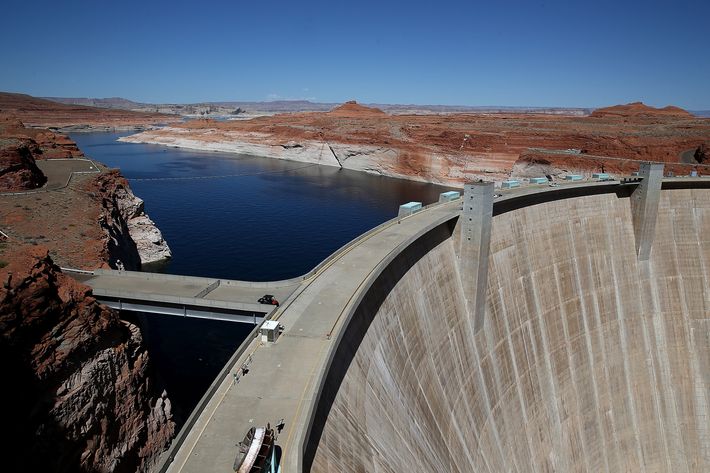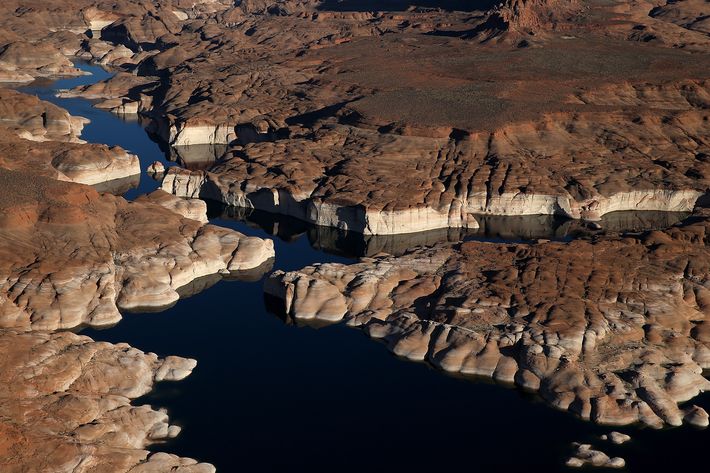
Lake Mead, America’s largest reservoir, reached a record low water level this week, breaking the previous record set a year ago. As of Friday night, the depth of the lake, which was formed after the Depression-era Hoover Dam was built on the Colorado River at the Nevada-Arizona border, had dropped to 1,074.33 feet, and the Desert Sun reports that officials expect the level to hit 1,071 feet by the end of June. The lake’s continuing decline amid 16 years of drought may automatically trigger significant cutbacks which would reduce the amount of water available to California, Arizona, and Nevada in the coming years, and as human-driven climate change intensifies, that supply problem will likely get a lot worse, according to experts. Those three states, and Mexico, all depend on water from the over-allocated Colorado River system, which provides water to one in eight Americans and a seventh of the nation’s crops. With the cutbacks looming, a new, politically-complicated sharing arrangement will need to be worked out to ensure the fair allocation of the water, and any agreement between a total of seven competing states and Mexico would likely need to be continually revisited as the water crisis worsens.
In light of these conditions, ProPublica has published a fascinating in-depth look at the renewed debate over what to do with the upriver Glen Canyon Dam in Arizona, which opened in 1963 and eventually formed the country’s second largest reservoir, Lake Powell. That lake also submerged hundreds of miles of red-rock canyons and otherwise pristine, if remote, desert wilderness — much to the chagrin of environmentalists then and since. Glen Canyon Dam, Hoover Dam, and more than 300 other dams and reservoirs were all part of an epic, decades-long $100 billion effort to provide water and hydroelectricity to the growing economies of the western U.S., and one that produced some truly remarkable feats of engineering in the process. But as ProPublica points out, many of these dams and reservoirs have turned out to be much less efficient than originally conceived, and in the case of the Glen Canyon Dam, even wasteful of the very resources they were meant to conserve.

While some plans to build new dams in the Colorado River basin persist, some experts and environmentalists now argue that not only should new dams be avoided, some of the old ones, like Glen Canyon, should be decommissioned. As a result of the ongoing drought and overuse of the river system, Lake Powell has now been drained to half of its capacity. In addition, because it’s a large body of water spread across a hot and windy desert, more than 160 billion gallons of water evaporate from the lake per year, and another 120 billion annual gallons may be leaking out through fissures below the surface. One environmental organization told ProPublica that as much as $350 million worth of water is being wasted away each year due to the dam — enough water for 9 million people. The dropping water level has also made the dam’s hydroelectricity contracts more expensive to fulfill, with that cost being passed along to taxpayers. Apart from water and financial concerns, environmentalists have also long sought to decommission Glen Canyon Dam in order to resurrect the (gorgeous) canyon ecosystem in Arizona and Utah that was flooded by the forming of Lake Powell. Now, the endless drought may have finally given those activists the most compelling argument to drain the lake that they’ve ever had.

As ProPublica explains, the crisis at Lake Mead, which some experts believe has a 50 percent chance of running dry within the next seven years, may provide a perfect pragmatic reason to get rid of Lake Powell. Since the two reservoirs are only 300 miles apart, the emptying of the upper body would thus fill the lower body, potentially saving as much as 179 billion gallons of water a year. Hoover Dam would still be able to control the water supply downriver, and higher water levels there would allow for greater and more efficient hydroelectricity production as well, recouping some of the power production that would be lost if Glen Canyon Dam was decommissioned. Thus, the argument goes that one full reservoir would be better than two half-full ones, especially when the one you’re draining is essentially a massive, leaky puddle sitting in the middle of a desert.
There remains much opposition to the “Fill Lake Mead” proposal, however. On one hand, some plans persist to divert even more of the Colorado River basin’s water before it even gets to Lake Powell (or Mead), diminishing the potential impact of any downriver re-engineering. On the other hand, because of how integral Glen Canyon Dam currently is to the overall management of the Colorado River system, the political and bureaucratic hurdles would be substantial, potentially even requiring an act of Congress.
Nevertheless, if water becomes scarce enough for the downstream economies that rely on it, it’s possible that the value of the potentially hundreds of billions of gallons of conserved water will trump any other concerns. In the meantime, the new record lows for Lake Mead and Powell will almost certainly continue, and just how the engineering-tamed west will adapt to the new normal of its perpetually diminishing water supply remains to be seen.






























